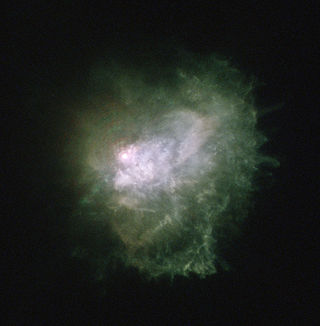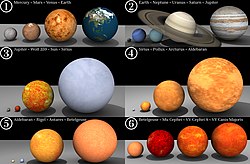VY Canis Majoris
| Stern VY Canis Majoris | |||||||||||||
|---|---|---|---|---|---|---|---|---|---|---|---|---|---|
 | |||||||||||||
| Aufnahme des Sterns und der umgebenden Gaswolke mit dem Hubble-Weltraumteleskop | |||||||||||||
| AladinLite | |||||||||||||
| Beobachtungsdaten Äquinoktium: J2000.0, Epoche: J2000.0 | |||||||||||||
| Sternbild | Großer Hund | ||||||||||||
| Rektaszension | 07h 22m 58,331s [1] | ||||||||||||
| Deklination | −25° 46′ 03,17″ [1] | ||||||||||||
| Helligkeiten | |||||||||||||
| Scheinbare Helligkeit | 8,08 mag[1] | ||||||||||||
| Spektrum und Indices | |||||||||||||
| Veränderlicher Sterntyp | SRc[2] | ||||||||||||
| Spektralklasse | M3 II/M4 II:[1] | ||||||||||||
| Astrometrie | |||||||||||||
| Radialgeschwindigkeit | +49 km/s | ||||||||||||
| Parallaxe | ca. 0,67 mas | ||||||||||||
| Entfernung | 3900 Lj 1200 pc | ||||||||||||
| Visuelle Absolute Helligkeit Mvis | ca. −3 mag[3] | ||||||||||||
| Eigenbewegung[4] | |||||||||||||
| Rek.-Anteil: | (+5,72 ± 2,01) mas/a | ||||||||||||
| Dekl.-Anteil: | (−6,75 ± 4,47) mas/a | ||||||||||||
| Physikalische Eigenschaften | |||||||||||||
| Masse | 35 ± 5 M☉ | ||||||||||||
| Radius | 1420 ± 120 R☉ | ||||||||||||
| Leuchtkraft | |||||||||||||
| Effektive Temperatur | (3600) K[2] | ||||||||||||
| Andere Bezeichnungen und Katalogeinträge | |||||||||||||
| |||||||||||||
VY Canis Majoris (VY CMa) ist ein Roter Überriese. Dieser Stern ist einer der größten Sterne der Milchstraße, deren Größe bekannt oder abschätzbar ist.
Eigenschaften
- Größenvergleich zwischen der Sonne und VY Canis Majoris
- Größenvergleich zwischen VY Canis Majoris (rechts) und verschiedenen Sternen
- VY Canis im Größenvergleich zu anderen Himmelskörpern (Bild 6, ganz rechts, neben VV Cephei)
Roberta M. Humphreys errechnete im Jahr 2006 den Radius von VY CMa auf das 1800- bis 2100-fache des Sonnenradius (R☉).
Neuere Untersuchungen aus dem Jahr 2012 deuten auf einen kleineren Radius von 1420 ± 120 R☉ und eine dafür größere Nähe von 1200 (statt 1500) Parsec (3900 Lichtjahre, 37 Billiarden km) hin.[5] Würde die Sonne durch einen solchen Stern ersetzt, dann würde sich dieser über die Umlaufbahn von Jupiter ausdehnen.
Es gibt zwei unterschiedliche Meinungen zur Zuordnung von VY CMa: Einige Forscher (so wie Roberta M. Humphreys in ihrer Arbeit)[6] meinen, der Stern sei ein sehr großer und sehr heller Roter Überriese. Andere (so die Untersuchung von Massey, Levesque und Plez)[7] hingegen kommen zu dem Ergebnis, dass VY CMa nur ein normaler Roter Überriese ist.
Der Namensteil „VY“ folgt den Regeln zur Benennung veränderlicher Sterne und besagt, dass VY Canis Majoris der 43. veränderliche Stern ist, der im Sternbild Großer Hund (Canis Majoris) entdeckt wurde.
2007 entdeckten US-amerikanische Astronomen um Lucy Ziurys bei Untersuchungen mit einem 10-Meter-Radioteleskop Cyanwasserstoff, Schwefelkohlenstoff, Natriumchlorid sowie Phosphor-Stickstoff-Verbindungen in der Umgebung des Sterns.[8] Diese umgebende Wolke ist auch der Grund, warum nur ein Bruchteil des vom Stern ausgehenden sichtbaren Lichts auf der Erde ankommt und VY CMa daher viel dunkler erscheint, als aufgrund seiner Leuchtkraft anzunehmen wäre.
Siehe auch
Weblinks
- VY Canis Majoris: The Astrophysical Basis of Its Luminosity (englisch)
- Kastner & Weintraub, HST Imaging of VY CMa (englisch)
- Eintrag zu VY CMa auf daviddarling.info
- Tiny blue dot auf YouTube – Sterne im Größenvergleich
- ESO: Geheimnis des Gewichtsverlusts eines alternden Sterns enthüllt 25. November 2015
Einzelnachweise
- ↑ a b c Hipparcos-Katalog (ESA 1997)
- ↑ a b c E. De Beck, L. Decin, A. De Koter, K. Justtanont, T. Verhoelst, F. Kemper, K. M. Menten: Probing the mass-loss history of AGB and red supergiant stars from CO rotational line profiles. II. CO line survey of evolved stars: Derivation of mass-loss rate formulae. In: Astronomy and Astrophysics. 523. Jahrgang, 2010, S. A18, doi:10.1051/0004-6361/200913771, arxiv:1008.1083, bibcode:2010A&A...523A..18D.
- ↑ grob abgeschätzt aufgrund der scheinbaren Helligkeit und der Entfernung
- ↑ Hipparcos-Katalog (2007)
- ↑ M. Wittkowski, P. H. Hauschildt, B. Arroyo-Torres, J. M. Marcaide: Fundamental properties and atmospheric structure of the red supergiant VY Canis Majoris based on VLTI/AMBER spectro-interferometry. In: Astronomy & Astrophysics 540, L12 2012, doi:10.1051/0004-6361/201219126
- ↑ VY Canis Majoris: The Astrophysical Basis of Its Luminosity
- ↑ Bringing VY Canis Majoris Down to Size: An Improved Determination of Its Effective Temperature
- ↑ Sterbender Stern als Quelle des Lebens
Auf dieser Seite verwendete Medien
Opaque red circle
Autor/Urheber: png original:Anynobody, vectorization: Henry Mühlpfordt, Lizenz: CC BY-SA 3.0
Einige massereiche Sterne im Größenvergleich zu unserer Sonne (ein einzelnes gelbes Pixel im Bild bei nativer Bildauflösung (2.876 × 2.068 Pixel)) und der Umlaufbahn der Erde (grau), des Jupiters (rot) und des Neptuns (blau). Die dargestellten Sterne von links nach rechts: die Sonne, der Pistolenstern, Rho Cassiopeiae, Beteigeuze und VY Canis Majoris.
Autor/Urheber: Dave Jarvis (https://dave.autonoma.ca/), Lizenz: CC BY-SA 3.0
Größenvergleich bekannter Planeten und Sterne
Autor/Urheber: IAU and Sky & Telescope magazine (Roger Sinnott & Rick Fienberg), Lizenz: CC BY 3.0
IAU Canis Major chart
Autor/Urheber: Judy Schmidt, Lizenz: CC BY 2.0
<a href="https://en.wikipedia.org/wiki/VY_Canis_Majoris" rel="nofollow">Canis Majoris</a> is one of those stars featured in <a href="https://www.youtube.com/watch?v=c8CgDGhYKe8" rel="nofollow">videos</a> seeking to give us perspective and show us just how massive stars can be. Forget Earth, this star dwarfs our Sun. Actually, forget the Sun too, because this thing dwarfs things that dwarf the Sun. Anyway, you get the point. It's ginormous as far as stars go. What you see here is the star and it surrounding nebulosity. Even though it's huge, we still only see it as the tiny bright point of light left of center from our vantage point. How's that for perspective? All stars, no matter how big, are actually pretty small. Stupid space, so big and always making everything seem so small. Space is a jerk.
I'm very happy with the results for this, too. I tried something different (again) without being sure what the results would be. There is some great, high resolution data in the archive for this object but it's all taken through polarized filters. I like polarized light images, but I think they may confuse people more than the usual amount that the strange, variable colors of astronomical processing often results in.
To generate an image of not-so-polarized light out of the polarized light images, I figured I could stack them into a single image and it would look about like it was taken without the polarizing filters. I reduced the diffraction spikes with masked curve adjustments. The <a href="https://en.wikipedia.org/wiki/Airy_disk" rel="nofollow">Airy disk</a> is apparent to the upper left of the star, but it's hard to do anything about it. Just know there aren't actually perfect concentric rings around the star.
I ended up using a large pile of files from the archive so I'm not going to list them all here.
Red: F685N Combination of polarized light images Green: F550M Combination of polarized light images Blue: hst_10262_01_wfpc2_f410m_pc_sci
North is up.








